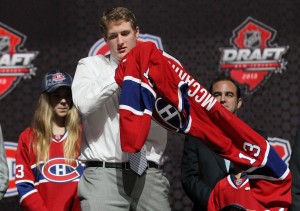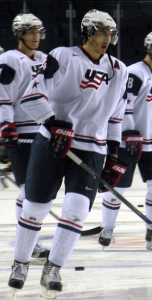Habs Draft Pick Distribution (2005-2013)
| Country |
All |
1st Round |
2nd Round |
3rd Round |
4th Round |
5th Round |
6th Round |
7th Round |
| CAN |
25 |
3 |
6 |
3 |
4 |
5 |
3 |
1 |
| USA |
19 |
6 |
1 |
3 |
2 |
2 |
0 |
5 |
| SWE |
6 |
0 |
2 |
0 |
1 |
0 |
2 |
1 |
| FIN |
3 |
0 |
1 |
1 |
0 |
0 |
0 |
1 |
| RUS |
3 |
0 |
0 |
0 |
1 |
2 |
0 |
0 |
| SWI |
2 |
0 |
0 |
2 |
0 |
0 |
0 |
0 |
| CZE |
2 |
0 |
0 |
0 |
1 |
0 |
1 |
0 |
| SVK |
1 |
0 |
0 |
0 |
1 |
0 |
0 |
0 |
| BLR |
1 |
0 |
0 |
0 |
0 |
0 |
0 |
1 |
| TOTAL |
62 |
9 |
10 |
9 |
10 |
9 |
6 |
9 |
Draft Picks by Country and Round for players selected 2005 to 2013 (inclusively) by Canadiens.

By Matthew Macaskill (@Habsology)
The Montreal Canadiens draft strategy has seen the Habs select 19 American born players since 2005 at the NHL Entry Draft, including six in the first round. While this number is still lower than the 25 Canadians selected in the same span, only three of the Habs nine first round picks from 2005 to 2013 were from Canada.
Furthermore, of the three Canadians selected, Louis Leblanc (2009, 18th overall) played in the United States for USHL’s Omaha Lancers the year he was drafted.
It’s interesting to note that five of the Canadiens’ nine picks in the seventh round since 2005 were from the United States. Players selected that deep in the draft are typically considered long-shots to make the NHL, so the scouting staff’s preference of Americans is significant.
The table below represents the average percentage of players drafted from Canada, the United States, and Europe from 2005-2007 in the NHL Entry Draft. While the Montreal Canadiens draft strategy has seen them select 7% fewer Canadian born players than the average, they are 4% higher than the average when it comes to drafting American players.
| NHL | Habs | |
| Canada | 47% | 40% |
| USA | 27% | 31% |
| Europe | 26% | 29% |
Averages indicated represent players selected from 2005 to 2013.
What is it about American born players has captured the attention of the Montreal Canadiens scouting staff?
It could be that the they simply scouted the United States more extensively than other countries. Or it might be that their confidence in the American development system gives the prospects the best shot at becoming professional hockey players.
US National Team Development Program
In the last 20 years, USA Hockey has restructured its development programs in order to improve both the number of players throughout their ranks and their potential. Founded in 1996, the US NTDP has produced a number of NHL stars, including Patrick Kane, Phil Kessel, Ryan Kesler, Jack Johnson, Ryan Suter, Kevin Shattenkirk, and goalie Jimmy Howard.
The program is composed of two teams. The first team is comprised of players under 17 years of age, while the second team is for players under 18.
![Michael McCarron played for both USA Hockey's U-17 and U-18 teams in the National Team Development Program. Mike McCarron [photo: Tom Sorensen]](https://s3951.pcdn.co/wp-content/uploads/2013/05/Michael-McCarron-300x240.jpg)
With exposure to international play and some of the best training in the world, members of the US NTDP are a good bet for NHL teams looking to add players with the potential for a long NHL career.
The American Development Model: Athletes First
In 2009, USA Hockey implemented the American Development Model (ADM) in hopes of resolving a trend that saw a large exodus of young players from the sport. The retention issue meant that there were fewer children proceeding through the country’s development system. This left USA Hockey at a disadvantage when it came to international competition and representation in the professional ranks.
The ADM focuses on a bottom-up structure that specializes in developing athletes by diversifying their training. This strategy avoids concentrating young children on a single sport. USA Hockey’s research shows that generalizing participation in different sports at a young age produces well-rounded athletes.
With the American Development Model and the National Team Development Program, selecting US born players is an encouraged draft strategy for NHL teams. USA Hockey’s ability to evolve has had a positive effect on the number of American players selected in early rounds of the NHL Entry Draft.
Missed this on the American Development Model. If this works out, USA Hockey could be the hockey superpower http://t.co/e7g1H5uvsC
— Corey Pronman (@coreypronman) July 4, 2013
The Montreal Canadiens draft strategy has already bought into the American prospect pool. If the trend continues for the Habs, it wouldn’t be outrageous to suggest that the roster will consist of US born majority sometime in the next next decade. This may prove to be controversal given that many believe the team’s French-Canadian roots are poorly represented by recent rosters.
McCarron Latest USHL Graduate for Habs
Michael McCarron (2013, 25th Overall) became the sixth American picked in the first round by the Habs since 2005, and the ninth since 2000. At 6’5 and 224lbs, the right-winger certainly has the size you look for in an athlete and he impressed during his first training camp with the Canadiens. The Gross Pointe, MI native should crack the NHL roster in the next two to three years.
McCarron is a good example of what the scouting staff and management are banking on with their investment in players rising through the NTDP and ADM with USA Hockey. McCarron laced up for both the U-17 and U-18 teams with the U.S. National Team Development Program in the last two years.
However, his decision to follow the Montreal Canadiens advice and leave the program to pursue his junior career with the OHL’s London Knights represents a reoccurring problem for USA Hockey’s development programs.
The bottom up development structure has its disadvantages. NHL teams are happy to draft capable, well-rounded athletes, but they’re confident that the best place to hone a prospect’s hockey skills is under the established tutelage of the CHL’s OHL, WHL, and QMJHL.
For McCarron, transferring to the Canadian Hockey League’s OHL offers an opportunity to play more games than he would at in college while working on his offensive abilities and hockey sense. But naturally, USA Hockey would prefer to retain their talent within the country’s borders.
For the Habs, McCarron follows in the footsteps of prospect Jarred Tinordi, whose transition from the USHL to the OHL’s London Knights appears to have panned out quite well.
Hits & Misses Among Habs American Picks

Both Alex Galchenyuk (2012, 3rd overall) and Max Pacioretty (2007, 22nd overall) will be competing with their countrymen for a roster spots at the 2014 Olympics in Sochi, Russia as part of Team USA’s youth movement.
Arguably the club’s best forward, Pacioretty is entering his sixth NHL season and looks poised to lead the team in scoring for a third straight season. Galchenyuk enters his sophomore season as a 19-year-old and should improve upon the 9 goals and 27 points he scored in a lockout-shortened campaign.
With injuries to Douglas Murray and Davis Drewiske, rookie Tinordi (2010, 22nd overall) has an opportunity to lock up a roster position and prove he’s there to stay in Montreal. The 6’6, 227lbs defenseman brings a much needed physical presence to the Habs blueline.
Ryan McDonagh is another American defenseman drafted by the Habs. He is currently carving out a successful NHL career with the New York Rangers thanks to a trade that saw Scott Gomez join the Canadiens.
The biggest bust at the draft table among the Montreal Canadiens American first round picks is defenseman David Fischer (2006, 20th overall). Fischer never panned out after completing his college career with the University of Minnesota. Fischer currently plays in Germany’s DEL for the Krefeld Penguins.
Timmins Discusses Montreal Canadiens Draft Strategy
Director of Amateur Scouting Trevor Timmins joined the organization in 2002. Since then he has maintained a trend that began in 2000 with the first round selection of American defenseman Ron Hainsey (13th overall). The team would go on to select Americans Mike Komisarek (2001, 7th overall) and Christopher Higgins (2002, 14th overall) before changes imposed post-lockout reduced the NHL Entry Draft to seven rounds in 2005.
I’m not a big fan of TT. He’s passed up alot of good players. Is he american? Didn’t do too much in Ottawa either.
Trevor Timmins is as Overrated a scouting director than Anyone at his job, Proof is that we had to sign Parros, an enforcer even the Worst team in the east didnt want, and since Timmins has been with Montreal for Twelve years now, that means in a dozen draft he hasnt been able to find the Habs a Fourth line enforcer, Sad.